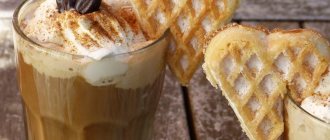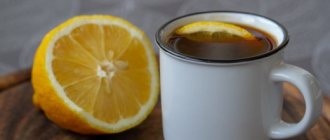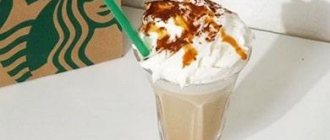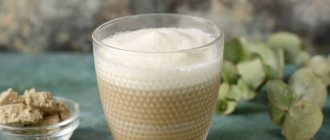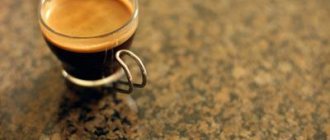Long before our compatriots actively began to visit Europe and became acquainted with the magnificent Caffè latte, in Russia they enjoyed drinking coffee with milk. It was offered in catering establishments, sold in stores in the form of powder or compressed briquettes, and prepared for breakfast in kitchens.
In those days when the children of the USSR gnawed sweet bars of “coffee with milk” - this was our favorite delicacy, Italian housewives made a revolution in the history of coffee drinks. Caring mothers, in order not to deprive younger family members of traditional morning coffee, began to dilute the strong drink with warm milk.
The simple cocktail is called Caffè latte, which is translated from Italian as “coffee with milk.” The future of the invention is excellent. Under the name “latte” it has gained love all over the world. Today, every coffee shop, bar, and restaurant prepares a wonderful drink with a white cap of foamed milk, which is coquettishly decorated with cute drawings.
It seems that we cannot prepare such a delicious dish at home without a coffee machine and special equipment. Still, let's try. We will definitely succeed!
Latte at home without a coffee machine or coffee maker
Don't have a coffee machine or coffee maker at home that can help you make espresso? We'll make do! Latte consists of only two ingredients - coffee and milk. Let's talk about coffee first. To make a latte, it must be strong and concentrated. We get this drink in two ways:
- We brew strong coffee in a Turk from high-quality finely ground beans;
- We use instant coffee, especially since recently an excellent mixture of instant and ground coffee has appeared in supermarkets.
A secret: I’ll share another way of cooking, Latin American. To be honest, I use it often, although some experts and connoisseurs do not approve of this method. If the coffee beans are fresh, selected, finely ground, then just pour boiling water over them, wait 1-2 minutes, stir with a spoon and the drink is ready! Using a French press is quite appropriate.
To make a delicious latte at home, you will have to work some magic on the milk. Let’s not complicate the process by measuring its temperature; use mixtures of different varieties (for example, cow’s milk with almond or soy). Let's take a traditional product for preparation, which is sold in stores. The question immediately arises: what kind of milk should I choose to froth better? Take the one you buy, adapt to any fat content.
Interesting: opinions on the percentage of fat content of milk for making foam vary. Some people use a low-fat product and consider it an ideal option, while others use maximum fat content, almost cream. I use milk with a medium fat content of 2.5-3.2%. The amount of protein in the product is more important; it is the main producer of foam when whipping.
An important condition is that the milk must be warm. Not hot, but warm 60-70°C. You can warm it up on the stove or in the microwave; if it gets too hot, it’s better to cool it down. Now comes the crucial moment: to get fluffy, dense, elegant milk foam.
There are several ways:
- 10 best coffee latte recipes from classic to pumpkin
- use a mixer or blender;
- froth milk using a French press;
- beat the milk product by hand in a regular glass jar.
If you decide to make a milk cap using a blender or mixer, first warm the product and then start whipping. You need to fill the container to 1/3 of the volume so that there is enough space for the foam to appear.
Description of latte
“Latte” translated into Russian means “milk”. In other words, it's coffee with milk. The main components of the drink are black coffee, preferably a mixture of Arabica and Robusta, milk and water. The ratio of brewed coffee and milk in the basic version is one to three. The predominance of milk makes the taste of the drink soft and refined. Robusta adds a pleasant bitterness to it, and Arabica adds a unique, recognizable aroma.
This recipe originated in Europe gradually, starting in the 17th century. When drinking black coffee, Europeans diluted it with milk, considering it too strong. For a long time the drink did not have a name. But by the end of the 19th century, recipes for making coffee with milk - cappuccino and latte - became widespread in Italy. There is also an opinion that the classic version of latte was invented in the USA by a native of Italy, Lino Mejorin, in the mid-twentieth century.
Latte is made with a lot of milk
In any case, the drink has now gained popular recognition, is widely in demand and belongs to the elite in many countries of the world. Various of its recipes have been created, healthy and tasty, aesthetically designed, with a special culture of presentation and unsurpassed aroma.
Difference from cappuccino
Despite the fact that the composition of latte and cappuccino are based on the same components, they differ in their ratio, method of combination, calorie content, and strength. In latte coffee, milk predominates (about two-thirds of the total composition), thereby reducing the presence of caffeine. It can be based on espresso or any other black coffee. Depending on the preparation method, the latte can be uniform in color and composition or in layers. The foam does not contain large balloons and has the consistency of cream, the so-called “wet”.
Cappuccino contains equal parts of coffee and milk. When mixing, the coffee is poured into the cup first, then the frothed milk. It has a pronounced coffee taste and a large volume of airy foam. It contains a higher percentage of caffeine.
Let's not get confused, even if there is neither a coffee machine nor a blender
It is quite possible to do without household appliances. Fill a medium or large French press flask less than halfway with milk and operate the plunger. Only it should be cold. Foam will appear quickly. When it’s cold, it’s better to froth milk in a jar. Pour 1/3 of the milk into the container, close the lid tightly and shake well in your hands for 1-2 minutes.
Beat the milk with a French press. Simple and convenient.
After the foam has formed to the desired consistency, place a glass jar without a lid or a French press flask without metal parts in the microwave and heat the component for the future latte. No more than 30-45 seconds! Make sure it doesn't run away!
Tip: to get fluffy foam, I use one very convenient device. It is called a milk frother or cappuccino maker. I bought it 5 years ago and couldn’t be happier. This small unit is inexpensive: in online stores from 300 to 400 rubles. Don't skimp and you won't regret it!
Cappuccino maker.
It's time to combine the two drinks. Clear glasses or Irish cream glasses are best for combining. In such dishes, the latte looks impressive, appetizing and neat. Layering, transitions of tones from dark brown to milky white are clearly visible behind the transparent walls. The beauty of the drink is crowned with a white balloon cap.
How to make a latte if you don't have a coffee machine at home
You can make a latte without a machine. It is advisable to have delicious coffee beans or ground on hand.
And so the availability:
- French press or blender;
- Turks;
- water 60 ml;
- milk 130 ml
- coffee and you will be able to enjoy your drink in no time.
In a Turkish boiler, brew 1 heaping teaspoon of coffee. Cook according to a special recipe. There is no need to boil, but put the Turk on the fire three times until bubbles appear (2-3 seconds).
After making espresso, you need to heat the milk to 70 degrees. Then pour into a blender and beat thoroughly (30-40 seconds). Strain the coffee through a sieve and pour in hot milk. You can add your favorite spices on top for decoration. A glossy smooth surface indicates that the drink is successful.
First coffee, then milk
Do you remember how Italian housewives prepared lattes for children? They added milk to the brewed coffee, i.e. The initial component is strong coffee. But the drink’s pattern is formed by milk whipped into fluffy foam. Slowly and calmly pour it into the finished hot coffee, do not stir.
The mystery of the birth of a real latte will take place before your eyes. This process will happen without your participation. Two wonderful natural products will become one, forming an amazing color composition.
Let's clarify the number of products required to prepare a luxurious and healthy delicacy:
| Latte ingredients | Quantity | |
| 1. | Ground coffee. You can use pure Arabica or a mixture of Arabica and 10-20% Robusta | 7-8 g, cooked 50-60 ml |
| 2. | Filtered or bottled water | 100-120 ml |
| 3. | Fresh milk, medium fat, warm | 100-180 ml |
| 4. | Sugar | To taste, you may not add |
| 5. | Flavoring additives | To taste and as desired |
The closest cousin of latte coffee is cappuccino, which is prepared from the same products. The difference between them is in the proportions of the components: a latte has much more milk and the milk foam is not too high.
History of appearance
The first recipe for coffee with milk, cappuccino, was invented in Italy. Until the beginning of the 19th century, it remained unknown to Europeans. The fashion for ancient culture led to a massive influx of tourists to the Apennine Peninsula. Most of them appreciated the cappuccino, but some found it so strong that they asked for more milk.
In 1847, the first ever mention of a cappuccino derivative, latte, appeared in one of the British newspapers. It was brewed in small Italian coffee shops for foreign guests. A detailed description of it was made by William Dean Howells in his book Italian Travels.
According to Americans, the birthplace of latte is the USA. Layered coffee owes its origin to migrant Lino Mejorin from sunny Italy, owner of the Mediterraneum bar in the town of Berkeley.
Recognition for the coffee-milk drink came in the 1980s, when latte spread to chain coffee shops around the world. Nowadays, it is most loved by business youth, and is also considered one of the signs of elitism in a number of Canadian cities and regions of the United States.
Let's diversify the taste of your favorite drink
In addition to the classic latte, a latte “with a twist” has a right to exist. Every home cooking lover has their own. Creative personalities with inspiration draw signature designs with chocolate chips on the foam cap; gourmets prefer to invent combinations of taste sensations.
- How to make a latte correctly: from the classic recipe to matcha
Syrups and spices are added to coffee. The most popular additives are: cinnamon, ground ginger or cloves, ground black pepper, cocoa, vanilla. The field for experimentation is large, but it is better to observe moderation. If you want to personalize your latte, start with tiny doses of the additive, it should only highlight the taste of the natural products.
Remember: the emphasis in the word latte is on the first syllable! This word is Italian, although we often pronounce it in the French manner with the emphasis on the last syllable. No more mistakes! Latte!
I am sure that many of our readers have already mastered the secrets of making a divine latte. I suggest not keeping them in your kitchen and sharing them with us in the comments. Sharing experiences among like-minded people is useful!
A latte is a special type of tonic drink that you probably don't try to make at home because you think it's too complicated. Maybe you just don't want to spend big on a fancy latte or espresso machine. We understand. But we think coffee desires shouldn't be limited by budget or lack of space.
That's why we decided to tell you how to make a latte without any expensive devices. It's easier than you think, so now you're not too far away from a fresh latte (or even a latte art session) made at home.
Throw a party with an elegant cocktail
You already know the classic latte recipe. You can no longer use the services of a barista in coffee shops, but make cocktails at home. Moreover, you can choose beautiful dishes. Please your family and friends with drinks. Arrange a romantic evening for two.
You can make a latte the traditional way with the addition of liqueur. Or you can brew several types of coffee and make cocktails with almonds, liqueur and milk. Nuts and coffee beans are ground together in a coffee grinder.
Then espresso is brewed with the ingredients, bringing to a boil three times. Then everything is poured into hot milk. Afterwards, pour the liqueur, put a beautiful foam on top and make a topping of grated chocolate.
You don't need an espresso machine
So, you don't have a machine that will froth milk or make espresso. But it's not a problem! Such a device, of course, greatly simplifies the process, but you can enjoy making latte at home without it.
You just need to plan the process, and you will have to work hard.
- Latte
To make a latte at home, you'll need more than a regular coffee pot. If you can't afford a coffee machine, we recommend purchasing a few tools that will make the process easier.
You may not have to buy anything at all, depending on what coffee making supplies you already have. In general, you will need:
- Device for making fresh milk.
- Milk frothing device.
- Device for making espresso.
How to make latte, drink recipes
- Large latte macchiatos. The milk is heated until hot. Aromatic espresso is brewed from Arabica coffee with the addition of Robusta beans. It is advisable to grind these grains right before cooking. In principle, ground coffee also makes excellent drinks. After the coffee has brewed, we begin to lay out the layers. Milk, then coffee, and then a finishing touch of foam.
This is how espresso, passing through a veil of milk, creates a layered drink together with the dairy product. But remember that rich, tasty foam will only come from full-fat milk. Nothing will come of a low-fat product.
- Pay attention to the famous Irish dessert Irish latte. Imagine, if it weren’t for the freezing journalist in the bar, who was waiting on board, like other travelers, no one would have known about such a drink. The barista took pity on the poor man, and with him the other tourists, and poured whiskey into the coffee to warm him up. And then he added cream to the coffee. The result is an Irish latte recipe. The difference between traditional coffee and Irish latte is the presence of layers in the latter.
- Magical patterns on latte can appear thanks to latte art. Experienced baristas can do this by pouring milk foam and at the same time creating patterns on it. Not everyone can achieve a beautiful ornament. But you can try. First, watch how professionals do it, for example on YouTube. And then you will succeed too.
- But sophisticated professionals have their own opinion. They don't consider milky layering a masterpiece. They are delighted by the appearance of a dark spot on the surface.
Preparing fresh milk
It is essentially heated milk. However, it is heated so that bubbles can form. In this case, the milk should not come to a boil, which will change its taste. This operation can be done in the microwave, but it is easier to control the stove. We recommend making fresh milk using the second method.
You will need:
- milk;
- small saucepan;
- thermometer.
Instructions:
- Pour the milk into a small saucepan and place it on the stove.
- Place a thermometer in the milk to monitor the temperature. If this is not possible, simply keep a thermometer nearby to check your temperature periodically.
- Heat the milk over medium heat. Depending on the type of product used, you will need to reach a certain temperature:
- Cow's milk: 65 degrees Celsius.
- Soy milk: 60 degrees Celsius.
- Almond milk: 54 degrees Celsius.
- Stir the milk periodically to prevent it from boiling. Once it reaches a certain temperature, remove it from the heat and pour it directly into the coffee or froth it.
How to make latte macchiato without a machine
Prepare:
- Ground coffee.
- 2.5% fat milk.
- Syrup or sugar.
- Water.
- A wide metal mug.
- Beater.
- Tapered tall glass;
- A deep spoon.
- Pitcher.
Make some coffee. Heat the milk (0.5), but do not boil. Pour the milk into a pitcher or metal container and whisk until foamy.
Approximately, you need to beat for 1 minute if the milk has heated to 70 degrees.
Lightly tap the mug on the table until large bubbles appear and disappear. When they are completely gone, you will get a dense and homogeneous consistency.
Add sugar syrup, milk to the container you will drink from and spread the foam on top using a deep spoon. Then carefully pour in the coffee so that the layers do not mix with each other. Unsightly foam can be trimmed with a knife.
Foaming milk
There are several options for making frothed milk. If you have a glass French press and a microwave, this process will take you a minute and a half.
You can also invest in a simple milk frother and milk jug (these will help satisfy your inner barista without having to spend money on an expensive espresso machine). You can foam the product in a simple glass Mason jar.
Foaming milk in a French press
Temperature and air are key factors to create fluffy milk foam. To achieve the same effect as using a milk frother or espresso machine, you can use the plunger of a French press to aerate the product and then heat it in the microwave.
You will need:
- cold milk;
- a French press with a glass flask or one that can be heated in the microwave;
- microwave.
Instructions:
- Fill the French press flask one-third full with milk.
- Press the plunger for twenty seconds until the milk doubles in volume.
- Set aside the lid and plunger. Remove any plastic or metal parts from the glass flask.
- Place the container in the microwave. Heat it until the foam reaches the very top (try to avoid letting it run off, you don't want to have to clean it up). This will take 30-45 seconds.
- Remove the flask from the microwave and enjoy the fresh foam.
Frothing milk using a frother and a milk jug
If you plan to make lattes more often, it's worth investing in a milk frother and milk jug. Both items can be purchased online for less than $30 each. They make the process more accurate.
You will need:
- new milk;
- milk frother;
- milk jug or small saucepan.
Instructions:
- Pour the fresh milk into a jug or leave it in a saucepan.
- Immerse the milk frother halfway in liquid. Make sure you have enough space to allow room for expansion (it can triple in size).
- Turn on the milk frother and slowly bring it to the surface of the milk. Lower the device back halfway in a gentle motion.
- Continue raising and lowering the appliance at an angle for 30-45 seconds or until your pitcher or pan is filled with foam.
Note: Be sure to read the manufacturer's instructions before using the milk frother. They may vary.
Foaming milk in a glass jar
Just like with a French press, you will essentially need to heat the milk after it has been aerated. You can use an airtight glass jar for this, although the foam will be somewhat coarser.
You will need:
- Milk.
- Glass jar.
- Microwave.
Instructions:
- Fill a glass jar about a third full with milk.
- Close the container.
- Shake the jar well. Continue doing this until the volume occupied by the milk doubles.
- Remove the lid and place the container in the microwave.
- Heat the jar for a maximum of 30-45 seconds. The foam should rise almost to the edges, but the milk should not escape.
- Remove container from microwave and enjoy.
Science Break: Why is milk so... frothy?
No, it's not the shaking, although that does play a role. The composition of milk itself - carbohydrates, proteins and fatty acids - is what allows foam to form. This is why alternatives to this product may produce different foam results.
It's best to think of milk as a food rather than a liquid, especially when heat is used. The fact is that the main components of the product coagulate in heat and can burn if it is overheated.
When you shake milk while frothing, the air begins to break down the casein, the protein it contains. However, it tends to remain in the same state, so a kind of shield is formed around the air bubbles. That is why the bubbles last longer and do not burst. If you want a very fluffy foam, look for milk that is high in protein.
For reference, take a look at the average protein content of milk and milk alternatives:
- Skim milk: 3.4%.
- 1% milk: 3.4%.
- 2% milk: 3.3%.
- Whole milk: 3.2%.
- Soy milk: 2.7%.
- Almond milk: 0.4%.
Don't forget: low protein content doesn't mean you'll get bad foam. It will just be a little different. The fact is that all these types of milk have different concentrations of carbohydrates and fats, which affects the creamy texture of the foam. For this reason, we prefer to use whole milk, the foam from which also lasts longer.
How to make coffee latte (best recipes)
A coffee drink from Italy was born in the middle of the last century. Latte appeared in the era of promoting a healthy lifestyle. In those years, it was believed that strong black coffee overloaded the body; people consumed it too often. This is how milk appeared in the classic espresso recipe.
The popularity of the latte coffee drink provoked the emergence of a whole art called latte art, and at the same time many interesting recipes began to be invented. Professional baristas skillfully painted the airy surface with various decorations, serving latte coffee in a charming appearance. Soon, fashion trends inspired a uniform structure - now this coffee is served in the same glass glasses, but not as a multi-layered drink with a pattern.
There is such a latte - macchiato
There is no difference in composition between the drinks; it is in the sequence of combining the ingredients of the cocktail. To make a latte, we pour milk into coffee and get a smooth, beautiful light coffee color with white foam on top.
To prepare a macchiato, the sequence is different: pour frothed milk into a transparent glass, and pour espresso on top in a thin stream. This is where we need a container with a spout; it is easier to form a thin stream through it. Masterfully pouring coffee over the blade of a wide knife requires skill and training. But the picture turns out flawless.
The picture is the layers that are formed as a result of this filling method. Heavy and dense milk will settle to the bottom, a layer of brown espresso will be placed on top of it, and the airy foam will rise to the upper “floor”. Additional layers, for example, of brightly colored syrups, will add variety to the palette. Decorate the foam cap in the same way as a regular latte.
Interesting! The essence of the name macchiato is that a stream of coffee poured into milk leaves a small dark spot on the white foam. Macchiato means “stained” in Italian, Latte macchiato means “stained milk”. This has nothing to do with the reputation of the drink! She's been on top for decades.
Latte macchiato is served on a saucer, which does not need a rim, but a spoon and a cocktail straw must be included. It’s convenient to eat the foam with a spoon, and use a straw to try each layer of the striped cocktail.
Literally translated, café latte is “coffee with milk.” It’s just that, unlike an ordinary and familiar drink, the milk needs to be frothed.
Why did people start putting emphasis on the second syllable in the word latte?
Who started to distort the word and put the emphasis on the second syllable in the word latte is no longer clear. This is what the British and the Americans and some of us do. The reason is the same for everyone - human nature, which wants to show off.
Funny words - manner, rail, pioneer, and coffee,
also the fruit of excessive show-off.
Such a show off, in order to emphasize an overseas word,
It even received a scientific name -
hyperforeignism
- hyperforenism. What is a type of hypercorrection? This is when grammar Nazis and pedants blindly transfer the rules of pronunciation of a foreign language without thinking that they no longer apply. You can easily recognize such people by their characteristic hello and [what], instead of [what].
In bars and restaurants you can often find lattes in 240 ml glass glasses - according to it. bicchiere
. When they bring you such a marvel, check the arrangement of the layers. If the milk is at the bottom, you have been served Latte Macchiato.
Making espresso
It is much easier to make steamed and frothed milk without an espresso machine than to make espresso without one. This is because the key to good espresso is pressure, and the machine is the simplest way to achieve the required values.
But this does not mean that it is impossible to make espresso without a machine. In fact, making espresso at home is a fairly simple process once you get the hang of it. You will need an Aeropress, geyser coffee maker or French press.
If you find similarities in the listed types of coffee makers, then you get the idea. All of these coffee machines use pressure to make coffee. Of course, it is not as strong as in an espresso machine, but these devices will be able to perform their task.
Since we've taken care of pressure, you'll also need to get dark roast coffee beans and, of course, a coffee grinder. Another key aspect of espresso is the fine grind, which is almost impossible to achieve without a proper grinder. Moreover, most of these devices are inexpensive and they also save you from labor and stress. What's not to like here?
Let's spice up the latte
Yes, a traditional latte is just milk and espresso. However, we live in a world of countless flavor combinations, so don't let a simple recipe stop you from adding variety to your latte. After all, why visit coffee shops for a latte flavor when you can make the same thing at home and spend less money?
Although syrup is often used, it is not the only way to add flavor to coffee. You can experiment with spices and baking supplies to make your latte taste better.
Don't know where to start? Try adding a pinch:
- Cinnamon;
- Cocoa powder;
- Nutmeg;
- Carnations;
- Cardamom;
- Ground ginger;
- Ground cloves;
- Black pepper;
- Chocolate chips;
- Peppermint extract;
- Vanilla extract;
- Almond extract;
Latte classic recipe
In a latte prepared according to a traditional Italian recipe, milk and coffee are contained in a ratio of 1:3. Since the proportion of milk is about 85%, latte has a delicate taste.
How to prepare:
- Prepare espresso.
- Whip the milk with a cappuccino maker. The resulting foam should be lighter and airier than for cappuccino.
- Foamed milk is poured into the cup, after which hot espresso is poured in a thin stream - the drink should be layered.
The most important thing when preparing a latte is working with milk: if it overheats, the taste of the drink will be irrevocably spoiled.
Basic requirements for foam:
- the presence of homogeneity in structure, without large bubbles;
- The consistency of the foam should be similar to cream (baristas call it “wet foam”).
Pros of an espresso machine
Yes, we talked about how to make lattes without any machines. But if you make lattes more often than regular coffee, then it might be worth investing in an espresso machine.
Espresso made without a machine isn't all that perfect. To make a good shot of this drink, you need to achieve precise water pressure and temperature. If you use alternative methods to prepare espresso, you may make mistakes and not get perfect coffee every time.
We understand that your coffee equipment dreams may be hampered by budget and kitchen space. But if that's not a problem for you, an espresso machine will make your morning latte faster and easier.
Making latte coffee using a household coffee machine
If you are the owner of smart household appliances, then you can create varieties of this drink. The imagination here is limitless. There are no boundaries for perfection.
To make a classic, you need to know the latte recipe and the machine will give it out in a matter of seconds. The main thing here is that you get heated milk and light foaming. Whether in coffee shops or homemade, the latte recipe is the same. Only different accessories can be used.
When users acquire household appliances in the form of coffee machines, it is not their only goal to make lattes. This is just one of the many varieties of coffee drinks that can be prepared using coffee machines.
Making a latte in a machine is a bit of a fascinating process. Because it combines a fresh drink and frothed milk... If the machine has a cappuccino maker, the preparation process is significantly accelerated.
Some cars do not have such options. Therefore, you just have to beat the milk with a whisk or call on other household appliances for help.
But this is not a hindrance to enjoying this delicious drink.
First, hot milk is poured into a beautiful tall glass with a narrowed bottom.
Then the espresso, which is prepared in a coffee machine, is slowly poured.
Due to the temperature difference, a three-layer drink is obtained.
Hot milk is given the lower place, coffee occupies the middle, foam decorates the entire drink on top.
Thanks to the dominance of the dairy product, the drink is so delicate that it entered drinking establishments with the status of a bestseller.
But you must admit, drinking cocktails in coffee shops is one thing. And how sometimes you just want to relax in a cozy home environment. Now that you have acquired a coffee machine, this is not at all difficult to do.
It was nice chatting, help yourself to a latte
You have all (or most) of the tools, and now the knowledge. Turn off your computer and get your latte ready!
Happy coffee making!
The word latte is of Italian origin. It is translated as milk, and accordingly the phrase “coffee latte” means coffee with the addition of steamed milk and foam. Milk softens the strong coffee taste, and whipped foam on top helps the drink not cool down and maintains the richness of the aroma. The cocktail is very popular in European countries and the USA and is similar to cappuccino.
Content
Preparation
You will need an Irish glass with a handle or another tall glass. You can immediately pour caramel or other syrup into the bottom.
- Brew espresso. If you have a coffee maker, the process is greatly simplified. If not, then brew ground coffee in a Turk, and then drain the sediment and be sure to strain through a sieve to get rid of grains.
- Whip the milk into a strong foam. If you have a coffee machine, then you need to pour about 1/4 of the milk into the pitcher and whip it using a cappuccino maker.
- If you don’t have a coffee machine, then you need to heat the milk to about 60 degrees (never boil!) and then whip it in a French press. Just pour in warm milk and press up and down to create foam. The milk should increase in volume by about 3-4 times.
- Pour heated milk with foam into a glass. Pour slowly, along the wall, so that the layers do not mix. The glass is almost full. Let it sit for 20 seconds (settled milk will separate the layers better).
- And finally, slowly pour the coffee into the milk - pour it down the side of the glass in a thin stream.
- The result is a beautiful and very tasty coffee with milk that does not need additional decoration. You can serve with a straw and a long coffee spoon.
- Enjoy your coffee!
Latte macchiato 04/19/2016
The main difference between a latte macchiato and just a latte is how it looks. In a glass glass, three layers are clearly visible: milk, coffee and milk foam. The more sharply the layers are separated from each other, the more beautiful the cocktail looks.
The taste of latte macchiato is delicate, milky, the coffee does not overpower, but gives a bright tint to the milk. Take another look at those beautiful layers, now blend them! The taste of the drink will become uniform. If the layers are not mixed, you will drink coffee first and then just milk.
To make latte macchiato we need
- Ground coffee - 6 g (teaspoon)
- Water – 50 ml
- Milk – 150 ml
- Turk
- French press
Milk foam can be sprinkled with grated chocolate or cinnamon.
About the recipe
Difficulty: Difficult Flavor: Mild Time: 12 min Servings: 1
1Brew coffee in a Turk. Just coffee and water, not the oriental style. Look at clear and detailed recommendations on how to brew delicious Turkish coffee. For now, let's put the coffee aside. You can brew coffee in another way, not necessarily in a Turk. 2 At the same time, heat the milk. The milk needs to reach about 70-75 ° C - steam forms above the milk, but bubbles do not yet appear. The main thing is not to boil the milk! Heat the milk on the stove or in the microwave. 3 Pour the milk into a French press and whisk vigorously, moving the piston up and down for about 30 seconds. Carefully remove the piston. Stir the foam with several rotations of the flask in your hand. Lightly tap the bottom of the flask on the table 2-3 times to break up large foam bubbles. 6 more ways to froth milk without a French press4 Pour the milk from the French press into a tall glass, and then spoon out the foam5 Very carefully, in a thin stream, pour the coffee into the center of the glass. It is best to pour coffee along the blade of a knife or an inverted spoon. The coffee will easily flow through the foam, but will remain above the layer of milk. The task is to pour it so carefully that the coffee and milk do not mix.7Latte macchiato is ready! If you did everything correctly, your latte macchiato will consist of 3 layers: milk, coffee and milk foam.
If you didn't succeed the first time, don't be discouraged. Drink some coffee and try again. But this time pour in the coffee even more carefully.
If the foam settles quickly, it means you haven't whipped it enough. Try beating twice as long. If this does not help, take milk from another manufacturer. You can take milk with less fat content; such milk makes foam easier.
Useful tips. How to make your latte even better at home
Fresh coffee
Take freshly roasted coffee beans. Gin them right before brewing.
Pure water
Non-mineral water from a bottle will reveal the taste of coffee best
Natural milk
Fresh natural pasteurized milk produces delicious foam
The most delicious coffee is the one that is roasted no more than 3-4 weeks ago and ground immediately before brewing.
It is better to take bottled water, but not mineral water. Filtered water will also work. The best water for brewing coffee.
Whole milk with a fat content of 3.5% or higher, with a protein content of 3% or more, will give a dense and tasty foam. What is the best milk to froth?
For latte, take a tall glass with a volume of 300-350 ml.
It is better to warm up the glass. This is easy to do: pour boiling water into it, wait 20 seconds and pour it out. The hot glass is ready!
Did you manage to pour the coffee in neat layers the first time? I didn’t succeed, but the second time, using a knife, the layers became clearer. Well, then everything started to turn out easy. How did you brew your coffee? How did you pour it into the glass? How did you froth the milk? Share your experience! Let's discuss!
And admit it, you didn’t stir the cocktail, but ate the foam with a spoon?


